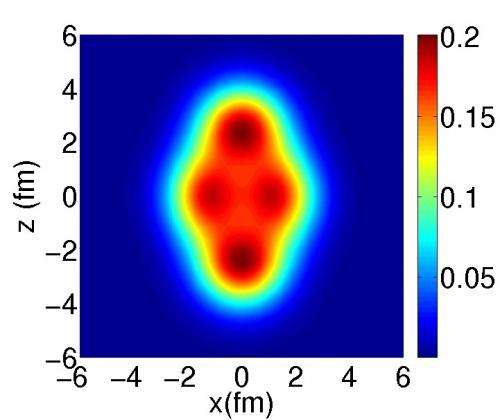The atomic nucleus: fissile liquid or molecule of life?

A new view of the nucleus that unifies its liquid and molecule-like aspects has been put forward by a team of researchers from France. By making an analogy with neutron stars, the researchers have for the first time demonstrated one of the necessary conditions for the formation of molecule-like behavior within the atomic nucleus. Such molecule-like behavior makes it possible to understand the synthesis of elements that are key to the appearance of life. The work is published in Nature on July 19, 2012.
The atomic nucleus is generally described as a drop of quantum liquid with a diameter of around a million billionth of a meter. In particular, such liquid-like behavior explains nuclear fission, and applies especially to heavy nuclei, i.e. nuclei that contain a large number of nucleons (neutrons and protons). On the other hand, light nuclei can behave like tiny 'molecules', or clusters, made up of neutrons and protons within the nucleus. This molecular aspect makes it possible to understand the stellar synthesis of carbon-12 and other heavier elements necessary for the appearance of life.
Until now, both the 'molecule-nucleus' and the 'liquid-nucleus' views coexisted. Now, a team from the Institut de Physique Nucléaire d’Orsay (Université Paris-Sud) and from CEA (the French Atomic Energy Commission), in collaboration with the University of Zagreb, proposes a unified view of these two aspects. By solving quantum physics equations on the scale of the nucleus (in particular the Schrödinger equation), the researchers have demonstrated that, although a light nucleus can show molecule-like behavior (tending towards the crystalline state), heavier nuclei take on a liquid-like behavior.
To establish this new theory, the physicists took inspiration from neutron stars1. The deeper you go inside a neutron star, the more you pass from a crystalline medium to a liquid medium. Thanks to this analogy, the physicists identified a mechanism of transition from the liquid to the crystalline state in the nucleus. When the interactions between neutrons and protons are not strong enough to fix them within the nucleus, the latter is in a quantum-liquid type state where protons and neutrons are delocalized.
Conversely, in a crystalline state, neutrons and protons are fixed at regular intervals within the nucleus. The nuclear molecule is interpreted as being an intermediate state between a quantum liquid and a crystal. In the long term, the aim is to attain a unified understanding of the various states of the nucleus.
More information: “How atomic nuclei cluster”, J.-P. Ebran, Elias Khan, T Nikšić and D. Vretenar, Nature, 19 July 2012.
Journal information: Nature
Provided by CNRS



















